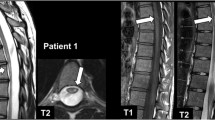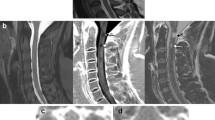Abstract
Diagnostic imaging criteria of multiple sclerosis (MS) include the spatial and temporal dissemination of cerebral and/or spinal cord lesions. Magnetic resonance imaging (MRI) is the method of choice for initial diagnosis and follow-up disease monitoring. Current guidelines for spinal MRI recommend sagittal imaging of the spinal cord and lesion confirmation on axial planes if lesions are detected. Sagittal imaging is, however, hampered by technical (e.g. partial volume effects, motion artifacts) and anatomical (e.g. scoliosis) limitations. We hypothesized that long coverage of the spinal cord by axial image acquisition has superior diagnostic performance compared to sagittal imaging and can identify otherwise undetected lesions. Our prospective clinical study included 119 MS patients. Axial MRI revealed ~2.5-fold more lesions than the sagittal angulation (axial lesion load: 4.0 ± 2.4 vs. 1.6 ± 1.2 lesions on sagittal planes, p < 0.001). Importantly, 20 patients (17%) with normal sagittal MRI scans had unequivocal lesions only visible on axial planes (mean lesion number on axial planes in these patients: 2.0 ± 1.3). Moreover, 45 patients (38%) showed a discrepancy of ≥3 lesions that were found additionally on axial scans (mean difference 4.4 ± 1.7). Additionally identified lesions were on average smaller in size and located more laterally within the spinal cord. No lesion on sagittal images was missed on the axial angulation. Our study demonstrates that imaging of small axial segments for lesion confirmation is insufficient in spinal imaging. We recommend implementing a long coverage axial MRI sequence for spinal imaging of MS patients.




Similar content being viewed by others
References
Frohman EM, Racke MK, Raine CS (2006) Multiple sclerosis-the plaque and its pathogenesis. N Engl J Med 354:942–955
Trapp BD, Nave K-A (2008) Multiple sclerosis: an immune or neurodegenerative disorder? Annu Rev Neurosci 31:247–269
Nijeholt GJ, van Walderveen MA, Castelijns JA et al (1998) Brain and spinal cord abnormalities in multiple sclerosis. Correlation between MRI parameters, clinical subtypes and symptoms. Brain 121:687–697
Lukas C, Sombekke MH, Bellenberg B et al (2013) Relevance of spinal cord abnormalities to clinical disability in multiple sclerosis: MR imaging findings in a large cohort of patients. Radiology 269:542–552
Noseworthy JH, Lucchinetti C, Rodriguez M, Weinshenker BG (2000) Multiple sclerosis. N Engl J Med 343:938–952
Traboulsee A, Simon JH, Stone L et al (2016) Revised Recommendations of the Consortium of MS Centers Task Force for a standardized MRI protocol and clinical guidelines for the diagnosis and follow-up of multiple sclerosis. Am J Neuroradiol 37:394–401
Wattjes MP, Rovira À, Miller D et al (2015) MAGNIMS consensus guidelines on the use of MRI in multiple sclerosis—establishing disease prognosis and monitoring patients. Nat Rev Neurol 11:597–606
Filippi M, Rocca MA, Ciccarelli O et al (2016) MRI criteria for the diagnosis of multiple sclerosis: MAGNIMS consensus guidelines. Lancet Neurol 15:292–303
Filippi M, Preziosa P, Rocca MA (2014) Magnetic resonance outcome measures in multiple sclerosis trials. Curr Opin Neurol 27:290–299
Renowden S (2014) Imaging in multiple sclerosis and related disorders. Pract Neurol 14:231–241
Wattjes MP, Steenwijk MD, Stangel M (2015) MRI in the diagnosis and monitoring of multiple sclerosis: an update. Clin Neuroradiol 25:157–165
Kearney H, Miller DH, Ciccarelli O (2015) Spinal cord MRI in multiple sclerosis—diagnostic, prognostic and clinical value. Nat Rev Neurol 11:327–338
Swanton JK, Rovira À, Tintoré M et al (2007) MRI criteria for multiple sclerosis in patients presenting with clinically isolated syndromes: a multicentre retrospective study. Lancet Neurol 6:677–686
Galler S, Stellmann JP, Young KL et al (2016) Improved lesion detection by using axial T2-weighted MRI with full spinal cord coverage in multiple sclerosis. Am J Neuroradiol 37:963–969
Kidd D, Thorpe JW, Thompson AJ et al (1993) Spinal cord MRI using multi-array coils and fast spin echo II. Findings in multiple sclerosis. Neurology 43:2632–2637
Bilgen M, Al-Hafez B, Malone TM, Smirnova IV (2005) Ex vivo magnetic resonance imaging of rat spinal cord at 9.4 T. Magn Reson Imaging 23:601–605
R Core Team (2016) R: a language and environment for statistical computing. R Foundation for Statistical Computing, Viennas. http://www.R-project.org/. Accessed 24 Nov 2016
Bot JCJ, Barkhof F, à Nijeholt GL et al (2002) Differentiation of multiple sclerosis from other inflammatory disorders and cerebrovascular disease: value of spinal MR imaging. Radiology 223:46–56
Sombekke MH, Wattjes MP, Balk LJ et al (2013) Spinal cord lesions in patients with clinically isolated syndrome: a powerful tool in diagnosis and prognosis. Neurology 80:69–75
Bot JCJ, Barkhof F, Polman CH et al (2004) Spinal cord abnormalities in recently diagnosed MS patients: added value of spinal MRI examination. Neurology 62:226–233
Schmidt R, Seiler S, Loitfelder M (2016) Longitudinal change of small-vessel disease-related brain abnormalities. J Cereb Blood Flow Metab 36:26–39
Wingerchuk DM, Carter JL (2014) Multiple sclerosis: current and emerging disease-modifying therapies and treatment strategies. Mayo Clin Proc 89:225–240
Winkelmann A, Loebermann M, Reisinger EC et al (2016) Disease-modifying therapies and infectious risks in multiple sclerosis. Nat Rev Neurol 12:217–233
Honce JM, Nagae L, Nyberg E (2015) Neuroimaging of natalizumab complications in multiple sclerosis: PML and other associated entities. Mult Scler Int 2015:809252
Rotstein DL, Healy BC, Malik MT et al (2015) Evaluation of no evidence of disease activity in a 7-year longitudinal multiple sclerosis cohort. JAMA Neurol 72:152–158
Weier K, Mazraeh J, Naegelin Y et al (2012) Biplanar MRI for the assessment of the spinal cord in multiple sclerosis. Mult Scler J 18:1560–1569
Montalban X, Tintore M, Swanton J et al (2010) MRI criteria for MS in patients with clinically isolated syndromes. Neurology 74:427–434
Okuda DT, Mowry EM, Cree BAC et al (2011) Asymptomatic spinal cord lesions predict disease progression in radiologically isolated syndrome. Neurology 76:686–692
Schlaeger R, Papinutto N, Zhu AH et al (2015) Association between thoracic spinal cord gray matter atrophy and disability in multiple sclerosis. JAMA Neurol 72:897–904
Schlaeger R, Papinutto N, Panara V et al (2014) Spinal cord gray matter atrophy correlates with multiple sclerosis disability. Ann Neurol 76:568–580
Acknowledgements
We thank L. Diebold and Dr. S. Bonekamp (Neuroradiology Department, University Hospital Heidelberg) for study support. We acknowledge funding from the Novartis Foundation for Therapeutic Research (Nürnberg, Germany). M.O.B. was supported by a physician-scientist fellowship of the Medical Faculty, University of Heidelberg, by the Hoffmann-Klose Foundation (University of Heidelberg) and by Neurowind e.V. The funders had no influence on the design, analysis or interpretation of the study.
Author information
Authors and Affiliations
Corresponding author
Ethics declarations
Conflicts of interest
The authors declare no conflict of interest.
Ethical standards
The study adhered to the declaration of Helsinki and was approved by the local ethics committee of the Medical Faculty, University of Heidelberg (study permit number: S-424/2012).
Rights and permissions
About this article
Cite this article
Breckwoldt, M.O., Gradl, J., Hähnel, S. et al. Increasing the sensitivity of MRI for the detection of multiple sclerosis lesions by long axial coverage of the spinal cord: a prospective study in 119 patients. J Neurol 264, 341–349 (2017). https://doi.org/10.1007/s00415-016-8353-3
Received:
Revised:
Accepted:
Published:
Issue Date:
DOI: https://doi.org/10.1007/s00415-016-8353-3




